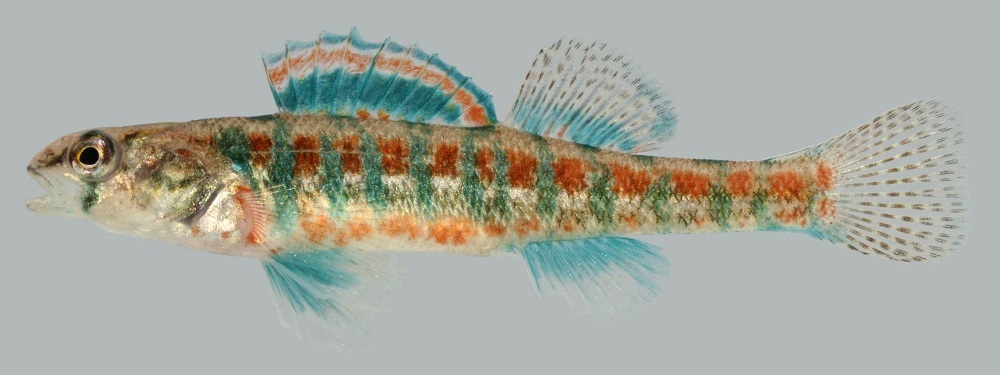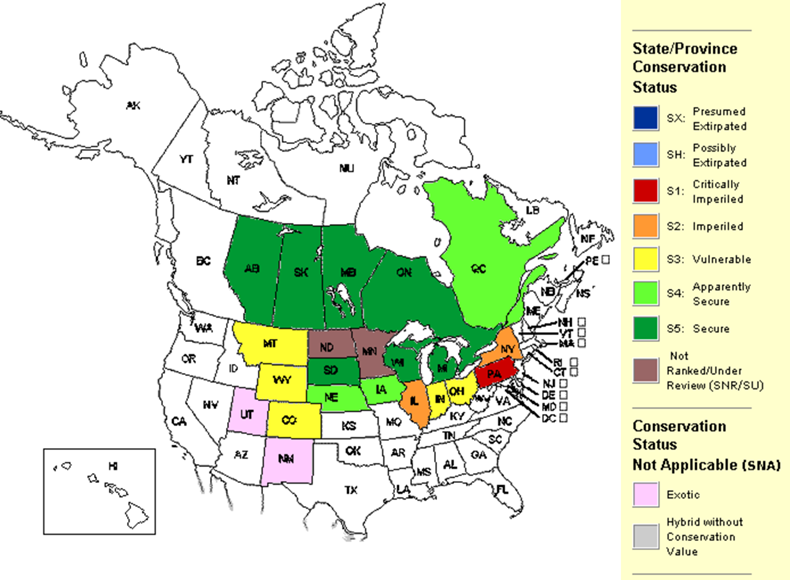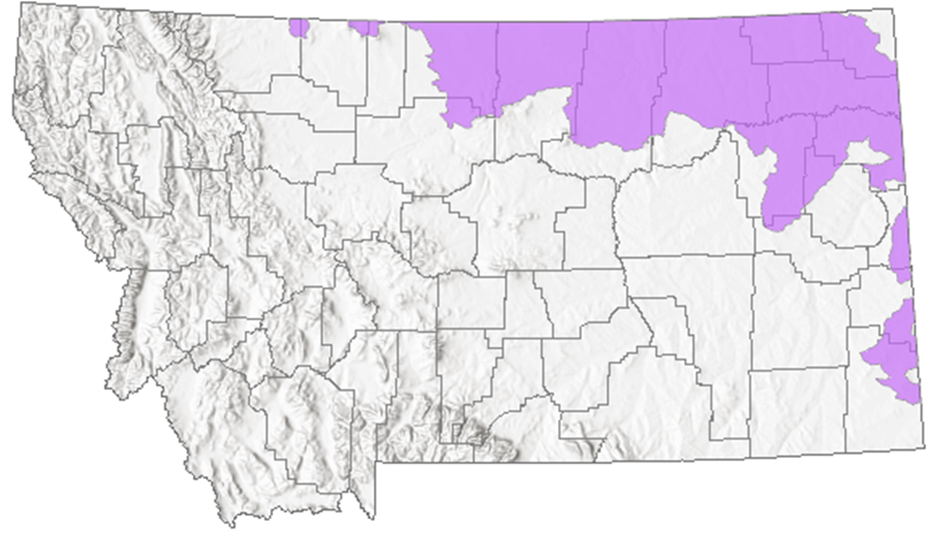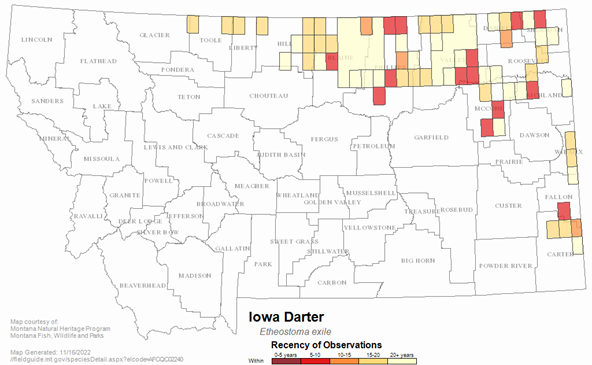Iowa Darter
Status of Iowa Darter (Etheostoma exile) in Montana
Christina Stuart and David Stagliano
IOWA DARTER STATUS PAPER (pdf)
DESCRIPTION
Iowa Darter (Etheostoma exile) are members of the Percidae (perches) family, one of the most diverse freshwater families of North American fishes (Page and Burr 1991). All North American percids are represented by darters except for three species (Walleye, Sauger, and Yellow Perch) (Helfman et al. 1997), yet darters seem to be the least known among the perches. The Iowa Darter is the only darter native to Montana (Holton and Johnson 2003).

Characteristics shared by the Iowa Darter and other percids include two dorsal fins (first spiny, second soft), thoracic pelvic fins, and ctenoid scales. Iowa Darter also has an arched lateral line that is incomplete, a black teardrop shape under each eye, and large, fan-shaped pectoral fins. A reduced or nonexistent swim bladder among darters may be the result of a preference for benthic habitats due to predation pressure or location of prey. The lack of a swim bladder allows darters to burry themselves in the substrate (possibly to hide from predators), make quick, swift movements with little energy (escape predators, catch benthic prey), and sink to the bottom when not swimming (hold position in swift currents among large substrate with little energy).

Figure 1. State conservation ranks of the Iowa Darter (Etheostoma exile) across its range.
STATUS
The Iowa Darter is listed as a species of special concern, “S3”, by the state of Montana indicating that the Iowa Darter may be “potentially at risk of extirpation because of limited and/or declining numbers, range and/or habitat, even though it may be abundant in some areas” (Montana Field Guide 2018).
The Iowa Darter is ranked “G5” Globally Secure, suggesting that this species, overall, are “common, widespread, and abundant (although it may be rare in parts of its range). Not vulnerable across most of its range.” (Montana Field Guide 2018). The Iowa Darter are listed from vulnerable (S3) to critically imperiled (S1) in seven other states besides Montana. The Iowa Darter are listed as secure or apparently secure (S4 or S5) throughout their Canadian range and most of the northern Great Lakes states (NatureServe 2016) (Figure 1).
DISTRIBUTION
The Iowa Darter occupies a large range across most of the northern states and provinces east to New York and west to Montana east of the continental divide, and south to the plains of Colorado (Page and Burr 1991) (Figure 1). This species has the most northern and western extent of any other darters (Page and Burr 1991), and Montana contains the western periphery of its continental range. Therefore, it is the only darter found in Montana, and the western Canadian provinces; western populations are patchily distributed in Colorado, Wyoming, Montana, and Alberta (Figure 1). In Montana, Iowa Darters are predominantly found in the northern part of the state (Northwestern Glaciated Plains), inhabiting tributaries to the Milk and Missouri Rivers (Figure 2). They are an indicator fish species of the reference condition Northern Glaciated Prairie Stream Ecosystem (Stagliano 2005). Iowa Darters have been collected in large numbers in the Beaver Creek drainage (10050014) (Stagliano, unpublished data 2012) and Rock Creek drainage (10050015) (Stuart 2022). Iowa Darters have been collected in fewer numbers in southeastern Montana in the Upper Little Missouri drainage (10110201) (Chaffin 2011a, Demuth and Stuart 2017, and Stuart 2022).


Figure 2. Iowa Darter Distribution (top) and Recency of collections (bottom) in Montana.
HABITAT, LIFE HISTORY, AND ECOLOGY
There is limited data on the preferred habitat of the Iowa Darter, but most information suggest they prefer slower moving waters as they have been found in lakes, ponds, and pools and backwaters of small streams and rivers. They also seem to prefer clean, clear waters, with vegetation, and a rocky bottom (Page and Burr 1991 and Copes 1976). In northeastern Montana, Iowa Darters have been collected in large numbers in gravel-bottomed stock ponds with rooted vegetation in the Beaver Creek drainage (10050014) (Stagliano unpublished data, 2012). Iowa Darter have also been found in clear, flowing waters with majority of the substrates ranging in size from 2 mm to 64 mm (fine gravel to coarse gravel) as well as backwater habitats with hard bottoms and submerged vegetation in the Rock Creek drainage (10050015) (Stuart 2022). In southeastern Montana darters have been found in low numbers in slow moving, clear, and heavily vegetated (submerged vegetation) creeks in the Upper Little Missouri drainage (10110201) (Chaffin 2011a, Demuth and Stuart 2017, and Stuart 2022). In North and South Dakota, Iowa Darter have been found in streams dominated by fine gravel (2 to 16mm) substrates as well as fine sediments with few coarse gravels (16 to 64 mm) and cobble (64 to 254 mm) sized sediments (Chaffin 2011a and Chaffin 2011b).
Food habits of the Iowa Darter have not been studied in Montana. The fact that other darters are known to be visual foragers (Winn 1958), and darters seem to prefer clear waters, would suggests that the Iowa Darter are visual feeders as well. In Wyoming and Wisconsin, Iowa Darter have been known to eat small crustaceans and mollusks such as amphipods, copepods, ostracods, and gastropods, small insects such as Diptera, Ephemeroptera, and Trichoptera, as well as animal remains (Copes 1976). Copes (1976) described Iowa Darters as insectivores and Bramblett et al. (2005) described them as benthic invertivores.
Reproductive characteristics have not been studied in Montana. However, spawning seasons have been described as lasting from April to July (Copes 1976) and May to July (Brown 1971). Studies of Iowa Darter in other geographic areas have found them to be sexually mature at age 1 with females producing anywhere from 200 to 1600 eggs (Brown 1971). Simon and Faber (1986) describe Iowa Darter as a phyto-lithophilic, depositing adhesive eggs on aquatic vegetation in shallow areas along shorelines. Brown (1971) describes spawning occurring in shallow areas with eggs laid on or among rocks. Larger adult males become brightly colored during spawning, probably one of the most brightly colored fish in Montana. Sexually mature males will develop bright green, red, and orange lateral bands on their body and fins, typically their pelvic, anal, and spiny dorsal fin. Additionally, some females may deepen their colors during spawning, but not as intense as the males.
THREATS
Iowa Darters are visual invertivores (i.e., insectivores) and prefer clean, clear waters. An increase in sediment load, turbidity or any habitat modifications that cause these conditions can pose a serious threat for this species. The presence and continued stocking of non-native predators (Northern Pike and Walleye) are also imminent threats for the Iowa Darter population across the Hi-Line of Montana, as they are for other members of this prairie stream assemblage (Stagliano 2008).
MANAGEMENT
The Iowa Darter is classified as a non-game species by Montana Fish, Wildlife, and Parks. Currently, there are no management plans or activities specific to the species. Establishing a program to monitor existing populations (every 3-5 years), and revisiting historical sites with Iowa Darter records, would be beneficial to determine population trends and potential range expansion or reduction. Sampling could be done during presumed spawning periods to further define spawning habits as there is little information specific to Iowa Darter in Montana. Protecting stream habitat currently occupied by darters and limiting or discouraging stocking of non-native predators (Northern Pike and Walleye) in drainages occupied by darters would be beneficial as well.
REFERENCES
- Brown, C.J.D. 1971. Fishes of Montana. Bozeman, MT: Big Sky Books/Montana State University. 207 p.
- Chaffin, J. 2011a. Prairie Stream Surveys on BLM Public Lands in Eastern Montana and North Dakota: 2010. Bureau of Land Management. Miles City, MT.
- Chaffin, J. 2011b. Prairie Stream Surveys on BLM Public Lands in Eastern Montana and South Dakota 2011 Surveys. Bureau of Land Management, Miles City, MT
- Copes, F.A. 1976. The Iowa darter, Etheostoma exile. American Currents, November/December.
- Demuth, B. and C.M. Stuart. 2017. Prairie Stream Surveys on BLM Public Lands in Eastern Montana 2017 Surveys. Bureau of Land Management. Miles City, MT.
- Helfman, G. S., Collette, B. B., and Facey, D. E. 1997. The Diversity of Fishes. Blackwell Science, Inc.
- Holton, G. D., and H. E. Johnson. 2003. A field guide to Montana fishes, 3rd edition. Montana Fish, Wildlife, and Parks, Helena.
- Iowa Darter — Etheostoma exile. Montana Field Guide. Montana Natural Heritage Program and Montana Fish, Wildlife and Parks. Retrieved on May 8, 2020, from Iowa Darter – Montana Field Guide (mt.gov)
- NatureServe. 2016. NatureServe Explorer: An online encyclopedia of life [web application]. NatureServe, Arlington, Virginia. Available http://www.natureserve.org/explorer (Accessed: May 8, 2017).
- Page, L. M. and Burr, B. M. (1991). Peterson Field Guide to Freshwater Fishes of North America North of Mexico. Boston: Houghton Mifflin Company.
- Simon, T.P. and D.J. Faber. 1987. Descriptions of eggs, larvae, and early juveniles of the Iowa darter, Etheostoma exile (Girard), from Lac Heney, Quebec. Canadian Journal of Zoology 65 (5): 1264-1269.
- Stagliano, D.M. 2008. Pearl Dace in the Big Muddy Creek Watershed: Extirpation Saved by the Barrier. Abstract at the Montana Chapter American Fisheries Society 41st Annual Meeting, Billings, MT.
- Stagliano, D.M. 2005. Aquatic Community Classification and Ecosystem Diversity in Montana’s Missouri River Watershed. Report to the Bureau of Land Management. Montana Natural Heritage Program, Helena, Montana. 65 pp. Aquatic community classification and ecosystem diversity in Montana’s Missouri River watershed : Stagliano, David M : Free Download, Borrow, and Streaming : Internet Archive
- Stuart, C. 2022. Prairie Stream Surveys on BLM Public Lands in Eastern Montana, 2022 Surveys. Bureau of Land Management. Miles City, MT.
- Winn, H.E. 1958. Comparative Reproductive Behavior and Ecology of Fourteen Species of Darters (Percidae) Ecological Monographs Vol. 28, No. 2 (Apr. 1958), pp. 155-191

